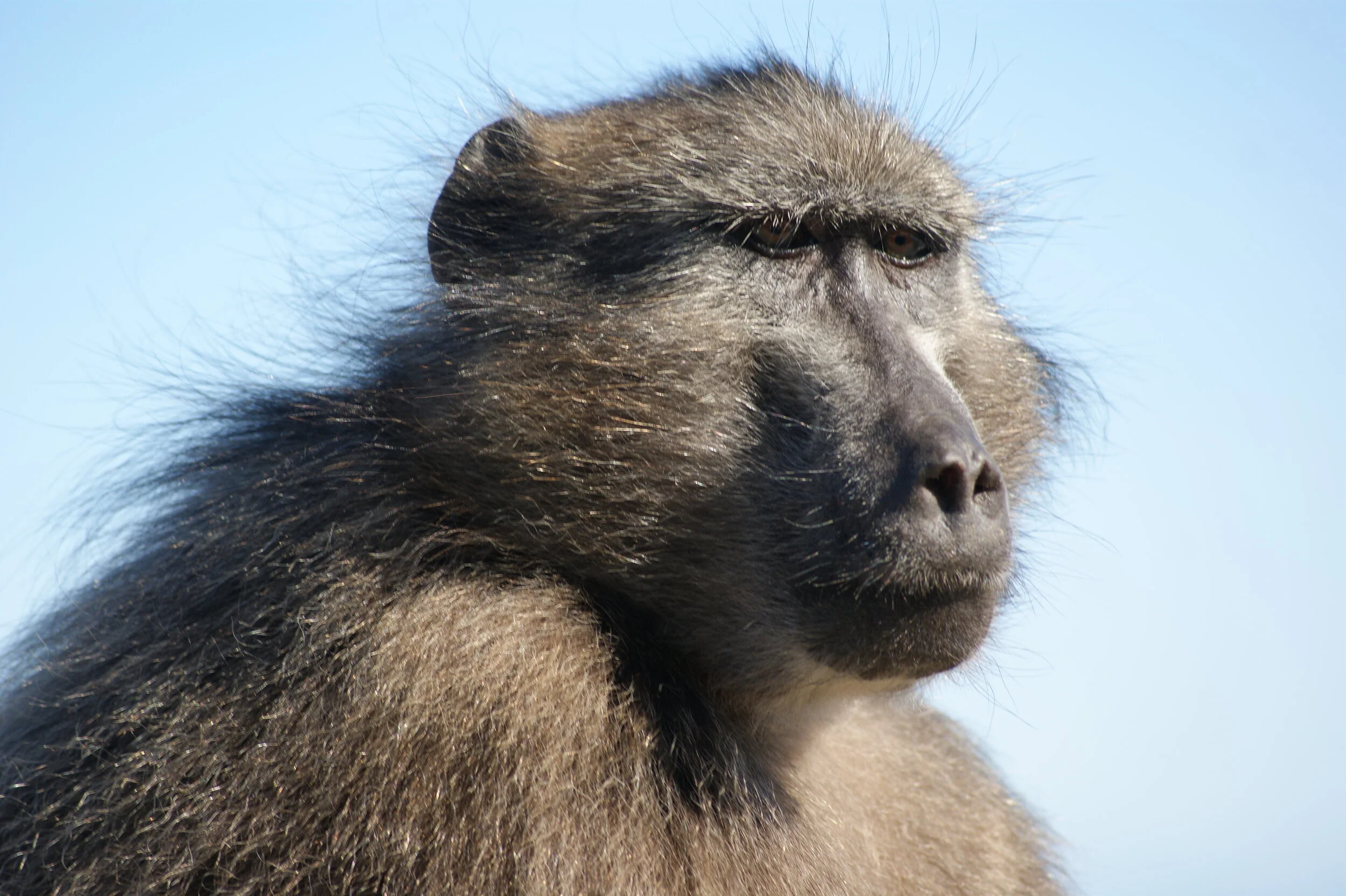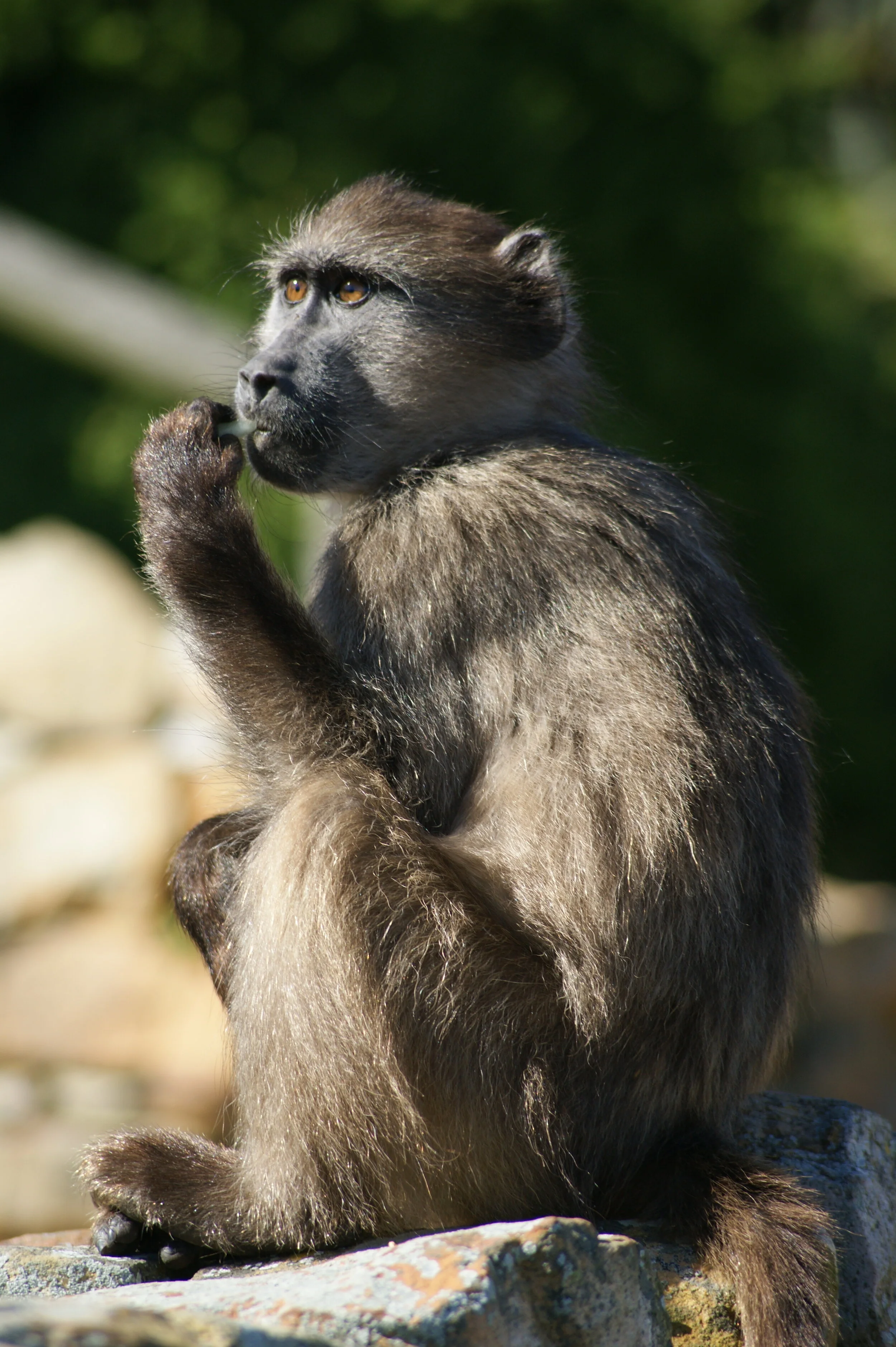![Zebra Surprise]()
Zebra Surprise
![DSC00834 2 34.jpg]()
DSC00834 2 34.jpg
![Impalas at Sunset]()
Impalas at SunsetThe impala is found in woodlands and sometimes on the interface (ecotone) between woodlands and savannahs
![Baboon Face On]()
Baboon Face OnBaboons vary in size and weight depending on the species. The smallest, the Kinda baboon, is 50 cm (20 in) in length and weighs only 14 kg (31 lb), while the largest, the chacma baboon, is up to 120 cm (47 in) in length and weighs 40 kg (88 lb)
![Male Baboon on Guard]()
Male Baboon on Guard
![Male Baboon close up]()
Male Baboon close up
![Zebra and Calf]()
Zebra and CalfThough they all live in Africa, each species of zebra has its own home area. Plains zebras live in the treeless grasslands and woodlands of eastern and southern Africa. The Grevy's zebra lives in in the arid grasslands of Ethiopia and northern Kenya. The mountain zebra is found in South Africa
![South African Buffalo]()
South African BuffaloThe African buffalo is a large sub-Saharan African bovine. Syncerus caffer, the Cape buffalo, is the typical subspecies, and the largest one, found in Southern and East Africa.
![Baboons on the Move]()
Baboons on the MoveBaboons vary in size and weight depending on the species. The smallest, the Kinda baboon, is 50 cm (20 in) in length and weighs only 14 kg (31 lb), while the largest, the chacma baboon, is up to 120 cm (47 in) in length and weighs 40 kg (88 lb). The smallest, the Kinda baboon, is 50 cm (20 in) in length and weighs only 14 kg (31 lb), while the largest, the chacma baboon, is up to 120 cm (47 in) in length and weighs 40 kg (88 lb)
![Lemur Monkey]()
Lemur MonkeyThe ring-tailed lemur is highly social, living in groups of up to 30 individuals. It is also female dominant, a trait common among lemurs. To keep warm and reaffirm social bonds, groups will huddle together.
![Baby Baboon]()
Baby Baboon
![Baboon eating]()
Baboon eating
![Calf Zebra]()
Calf Zebra
![Zebra Calf in the plains]()
Zebra Calf in the plains
![Spring boxers on the Plains]()
Spring boxers on the PlainsNational Animal of South Africa, ie; Ruby Team called South Africn Spring boxers.
![Springbok male]()
Springbok maleSpringbok have ringed, curved, black horns that are present in both males and females. They can reach lengths of 48 cms (19 inches) in males, but females have shorter, thinner horns.
![Mother and Child Rhino]()
Mother and Child Rhino
![Rhino and Baby heading Home]()
Rhino and Baby heading Home
![Rhino Grazing]()
Rhino Grazing
![Rhino as big as a Jeep]()
Rhino as big as a Jeep
![Mother and Calf Moose 1999 1/3]()
Mother and Calf Moose 1999 1/3
![Sawtooth National Park Mother and Calf Moose 2/3]()
Sawtooth National Park Mother and Calf Moose 2/3
![Sun Valley Moose 3/3]()
Sun Valley Moose 3/3
![African Oryx]()
African Oryx They have a grey coat with a white underside, separated from the grey by a stripe of black. There are also black stripes where the head attaches to the neck, along the nose, from the eye to the mouth and on the forehead. The mane is small and chestnut-colored. The ringed horns are thin and straight. they are found on both sexes.
![Calling Out - Oryx]()
Calling Out - OryxThe East African oryx is a species of antelope from East Africa. They have a grey coat with a white underside, separated from the grey by a stripe of black. There are also black stripes where the head attaches to the neck, along the nose, from the eye to the mouth and on the forehead. The mane is small and chestnut-colored. The ringed horns are thin and straight. they are found on both sexes
![Waterbucks]()
WaterbucksA robust, somewhat “overweight” animal found in small herds and dominated by a bull. As its name implies, waterbuck love water though they will often venture some distance away from it to feed. Two subspecies co-exist The common waterbuck with a distinctive white ring on its rear (see below), and the defassa waterbuck that has a white rump patch (pictured above).
![The Greater Kudu-Endangered Species]()
The Greater Kudu-Endangered SpeciesThe Greater Kudu or Tragelaphus strepsiceros is a striped antelope that inhabits the woodlands of eastern and southern Africa. Their population is declining due to loss of habitat and hunting
![Female Nyala Fawn]()
Female Nyala FawnAnother striped antelope is the Nyala or Tragelaphus angasii. This Southern African antelope has spiral horns and can grow up to 110 cm. Female species are reddish-brown with white vertical striping.
![Curious White Baby Rhino 2/4]()
Curious White Baby Rhino 2/4
![Nursing Rhino 3/4]()
Nursing Rhino 3/4A baby rhino is called a calf. Adult males are bulls. White rhinos are actually gray
![White Baby Rhino and Mama 1/4]()
White Baby Rhino and Mama 1/4
![White Rhino heading Home 4/4]()
White Rhino heading Home 4/4
![Cape African Buffalo great Bulls with great Horns]()
Cape African Buffalo great Bulls with great Horns
![Carabao King of the Road = Philippines]()
Carabao King of the Road = Philippines
![South African Horn bill]()
South African Horn billSout African hornbill, (family Bucerotidae), any of approximately 60 species of Old World tropical birds constituting the family Bucerotidae (order Coraciiformes).
![Cape Water Buffalo Herd]()
Cape Water Buffalo HerdThe African Water Buffalo (Syncerus caffer), also known as the Cape buffalo, thrives on virtually all types of grassland habitat in sub-Saharan Africa. They are found in savannah and woodland mosaics, preferring areas with access to water, grass, and dense cover (for example, thickets, reeds, or forest).
![Jungle Life-Baboons & Waterbucks]()
Jungle Life-Baboons & WaterbucksThe waterbuck (Kobus ellipsiprymnus) is a large antelope found widely in sub-Saharan Africa. It is placed in the genus Kobus of the family Bovidae.
![The Most dangerous game animal in the world]()
The Most dangerous game animal in the worldThe African Water Buffalo undergoes seasonal breeding. Cows have their first calves when they are about five years old, while bulls are mature at about eight years. Gestation is around 340 days— the longest gestation period in the bovine family. Females give birth to a single calf weighing 50-90 pounds






































